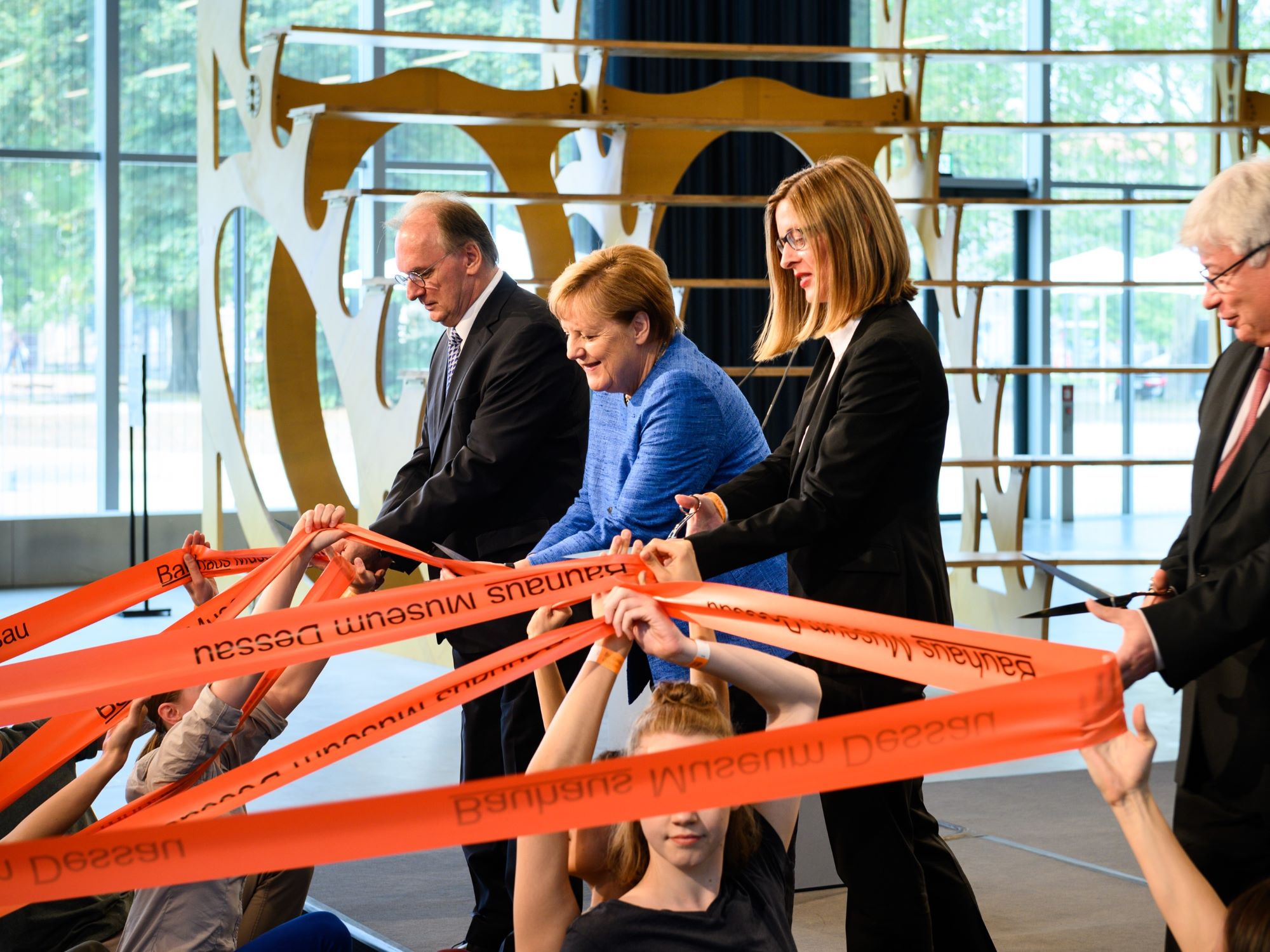
The Bauhaus arrived in Dessau with a bang. The world’s most influential art school may have been born in Weimar, but it came of age when it moved in 1925 to what was then Germany’s “silicon valley.” A new Bauhaus museum in Dessau tells the story of how the socially-engaged school of architecture and design flourished briefly until growing pressure from the Nazis forced it to leave for Berlin.
When in 1938 New York’s Museum of Modern Art canonized the school’s astonishing achievements, the former Bauhaus professor Josef Albers argued with its founder Walter Gropius that the revolutionary learning at the heart of the school should be highlighted in the survey show. Albers finally gets his say at the new Bauhaus Museum Dessau, the second of three new museums to open in the Bauhaus centenary year.
Hailing the museum as a “wonderful thing,” German chancellor Angela Merkel said at the opening ceremony on Sunday that for her the Bauhaus was a beacon in a “multitude of tastelessness we were surrounded by in the German Democratic Republic.”
Thirty years after the fall of the Berlin Wall, this still holds true. The newly erected building puts to shame many of the post-unification buildings in the former East German city’s tacky commercial center, as well as Eastern German prefab architecture.
Claudia Perren, the director of the Bauhaus Dessau Foundation, said that the new museum was created not only as a “venue for the presentation of our internationally renowned collection, but also a new cultural venue for the City of Dessau-Roßlau, and the State of Sachsen-Anhalt.” It aims to celebrate the legacy of the Bauhaus, and stay true to its spirit of openness to new ideas.
The new Bauhaus Museum Dessau. Copyright Stiftung Bauhaus Dessau.
Big Is Beautiful?
The competition-winning design of the vast Bauhaus Museum Dessau is a far cry from Gropius’s landmark Bauhaus Building, or the Masters’ Houses a mile away. The young Spanish practice addenda architects’s building resembles a not-quite-welcoming bar overlooking the city park in the small East German town, which has been wrecked by the post-wall exodus of industry and many of its younger generation.
Built in less than three years, on a budget of €28 million ($31 million), the museum building is a 393-foot-long glass block overlooking a city park. Inside visitors find a large, open foyer where a concrete “black box” sits atop a steel-work construction.
The massive building—has nearly 5,000 square feet of exhibition space in total—stands in stark contrast to the airiness of the original Bauhaus Building designed by Gropius. The inaugural exhibition is a comprehensive and sometimes surprising survey of the products designed by Bauhaus teachers and students in the school’s Dessau heyday. Called “Versuchsstätte Bauhaus,” the show features more than 1,000 objects drawn from a 49,000-strong collection, which is second only to Berlin’s.
The exhibition opens with a replica of László Moholy-Nagy’s light installation, Licht-Raum-Modulator (1922-1930), and a set of costumes from Oskar Schlemmer’s Triadic Ballet, reflecting the Bauhaus founders’ fascination with movement and transformation. The exhibition includes the story of how the rise of National Socialism forced the Bauhaus school to leave Dessau for Berlin within seven years, and led to its eventual closure in 1933 after Hitler seized power.
But this obligatory reference remains the only political context in the exhibition, which opens in a city where the right-wing Alternative für Deutschland party has become the second strongest political force. Instead, the politically neutral exhibition chooses to add one more milestone to the traditional narrative of the Bauhaus founders’ as visionary modernists.
Oskar Schlemmer display, Bauhaus Museum Dessau. Copyright Stiftung Bauhaus Dessau.
Female Bauhaus
The Dessau period is honored with a showcase of the school’s most iconic pieces, including Marcel Breuer’s Wassily Chair, and furniture from Mies van der Rohe’s 1929 Barcelona Pavilion. They highlight the school’s shift towards industrial design and architecture. Next to the classics, there are detailed teacher-student pairings, such as Wassily Kandinsky and Grete Reichardt. These displays illustrate the methods of teaching, the mutual influences and the interactions between the different artistic disciplines within the Bauhaus. Finally, the exhibition look Bauhaus’s influence across in the world, its rediscovery in the German Democratic Republic, and the foundation of the Dessau collection in 1976.
While many of the insights into the school’s life and the processes behind the iconic designs are refreshing, the first exhibition of the Bauhaus Museum Dessau fails to grapple with the complexity and contradictions of the school’s history. It overlooks how at the male-dominated institution many female students were sent to the Weaving Workshop. While one of the most successful of the workshops, it played second fiddle to architecture and industrial design. Inexplicably, Lilly Reich is not even credited alongside Mies van der Rohe for her contribution to the Barcelona Pavilion.
For the museum’s opening, the ample foyer space is filled with installations by contemporary artists Lucy Raven and Rita McBride. The museum has the space and the collection to present a more nuanced exploration of the Bauhaus movement in the future. It would also benefit from putting its achievements in a contemporary context as Germany grapples with the consequences of an unequal reunification between East and West, and rising right-wing populism. The second of three museums to open during the Bauhaus centenary celebrations after the one at its birthplace Weimar, and head of Berlin, the Bauhaus Museum Dessau could be a fortress against the rising reactionary forces that the school faced a hundred years ago, if rightly programmed.